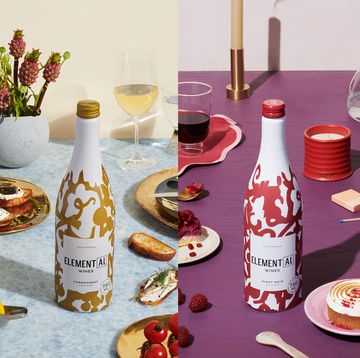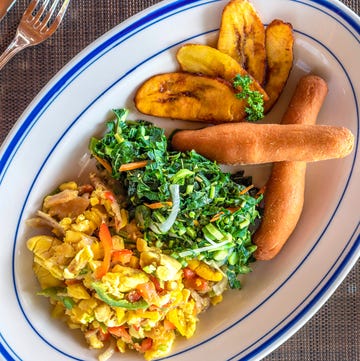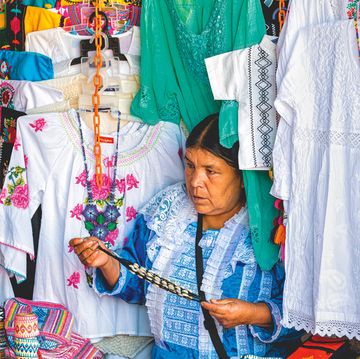In 1985, 31-year-old Nancy Silverton moved to New York from Los Angeles to take over the kitchen of a restaurant called Maxwell's Plum with her then husband Mark Peel. Anita Lo was studying French literature at Columbia University. At age 11, in Birmingham, England, April Bloomfield had dreams of joining the police force. Meanwhile, a toddler named Christina Tosi was living in Springfield, Virginia, probably licking whatever bowl of batter her grandmother had put in front of her. Men ruled the food world—David Bouley, Eric Ripert, and Jean-Georges Vongerichten among them—and were celebrated in the pages of ELLE.
Over the next two and a half decades, as the word "celebrity" became affixed to "chef" and cooking professionally became a focal point of pop-cultural discourse, women were generally left out of the conversation. In the last couple of years, that has changed as the media—and, subsequently, the public—has actively begun to cherchez la femme in the toque. That's one reason that when it came time to celebrate our birthday, there was more recognized female talent to choose from.
And yet the standouts were obvious: Today, Silverton is the co-owner of Osteria Mozza and Pizzeria Mozza, with outposts in L.A., Newport Beach, and Singapore. Lo has one of the first chef-driven, upscale small restaurants in the country; 15 years in, Annisa, in New York's Greenwich Village, remains a destination for critics and foodies. Bloomfield is the co-owner of five landscape-changing restaurants, the first of which, Manhattan's The Spotted Pig, put British gastropubs on the U.S. dining map in 2004. Tosi is the chef, founder, and owner of New York City's Milk Bar bakeries, home of the famous Compost Cookie and bottled Cereal Milk. Each has authored at least one cookbook. Collectively, they've racked up numerous awards, garnered Michelin stars, and made the television rounds.
Last month, Bloomfield hosted Lo, Silverton, and Tosi for lunch at the John Dory Oyster Bar in Manhattan. Each chef brought a dish and her unique perspective on the last three decades, to the table.
What's most obviously changed in the food world over the last 30 years?
Nancy Silverton: Television! I think it's safe to say that all of us got into this business because we love to cook, right? That's not true with everybody. Dr. Tim Ryan of the Culinary Institute of America was saying that now the students that enter the school first go to media training before they go to cooking school. I didn't start cooking because I wanted to act, or because if I cooked, then I'd make it big because I'd get on television.
Christina Tosi: The access is different. Before, if you wanted access, you would have worked for someone, right? Where now if you want access to someone's food, there are so many different ways that you can do it, even just through cookbooks, through websites, through blogs.
Any predictions for the future of the food world?
April Bloomfield: Middle Eastern food.
CT: The pendulum will continue to swing between fine dining and casual. It's really interesting to [watch]: Every time it swings to fine dining, it doesn't just swing to fine dining. It swings to fine dining with some crazy evolution.
NS: That's regional, though. Because you know, Los Angeles, for so long, has not been able to support fine dining. I mean, we have two restaurants [Providence and Mélisse], and that's it…. It has a lot to do with Wall Street [in New York], for instance. [In L.A.] you'll never see a Le Bernardin. Hollywood drives Los Angeles, right? So the Hollywood executives, they're wearing blue jeans and T-shirts and they're not eating at Le Bernardin, which is a shame, because when you want that celebratory experience, you have two choices, which are great choices, but….
Are you noticing any differences with the generation of cooks starting out now?
AB: You have to learn the foundations first…and that's an issue now, because kids don't want to put in the time, and they don't want to put in the effort of the process of learning and absorbing, and the building of your career.
Anita Lo: Technology is also adding to that. You know, you can just put something in a bag and put it in water and put on a timer. I'm finding cooks coming to me who don't even know how to sauté something.
Switching gears, what is it like, as chefs, to also be entrepreneurs?
CT: I think being a female and being younger, people don't take you as seriously, which, for me, is like, "Don't take me seriously. I don't really care. You can take me however you want." They're still kind of looking behind you for, like, a grown-up man in a suit.
AL: I think there are [still] a lot of [women] who have opened many restaurants but couldn't raise money to open their own places in New York. It's unfortunate.
Inroads have certainly been made. How have opportunities for women improved?
NS: To answer honestly, I've never had an issue, and I was never brought up to think there was an issue. So the restaurants that I was lucky enough to work at were restaurants that were run by young, open-minded—it turned out—gentlemen. But I never thought that I couldn't be anything other than what my own skills and devotion limited me from being.
AB: Yeah, same as me. I didn't go into this business thinking I was a woman in a man's world. I had a goal: I just wanted to work hard, earn my own money, and be successful—that was my ultimate goal. I never really had any problems being in a kitchen.
NS: With being abused or not taken seriously?
CT: No, not more than any other cook on a line, where it's like, you learn to take criticism and that's about it.
AB: You absorb and you suck it up and you work hard. You keep your head down, you ask questions, you learn, you make mistakes, you learn from your mistakes, and then, you know, you go to another restaurant. And usually you pick restaurants you really admire or the chefs you admire. You wanna work there, you want to learn from them. No, I never had an issue with being a woman.
NS: My heroes, at the time when I was just starting my career, were Barbara Tropp and Joyce Goldstein and Alice Waters and Judy Rodgers. You know, it was just women I looked at. If they could do it, then I could.
This article originally appeared in the September 2015 issue of ELLE.













